Law & Legal Frameworks: Quantity Surveying and Dispute Resolution
VerifiedAdded on 2021/09/27
|25
|8952
|314
Report
AI Summary
This report, prepared for the Colombo School of Construction Technology, delves into the critical intersection of law and quantity surveying, specifically addressing the role of quantity surveyors in dispute resolution and property law. The assignment explores the application of Alternative Dispute Resolution (ADR) methods, differentiating between adjudication and arbitration, and evaluating their effectiveness in resolving construction disputes. It examines the legal aspects of land acquisition, conveyancing laws, and the rights associated with real property ownership, including mechanisms for avoiding nuisances. The report analyzes a scenario involving a construction company facing disputes and property acquisition needs, offering insights into how a quantity surveyor can navigate these legal and contractual complexities. The report also includes an introduction, acknowledgement, and references to support its findings.
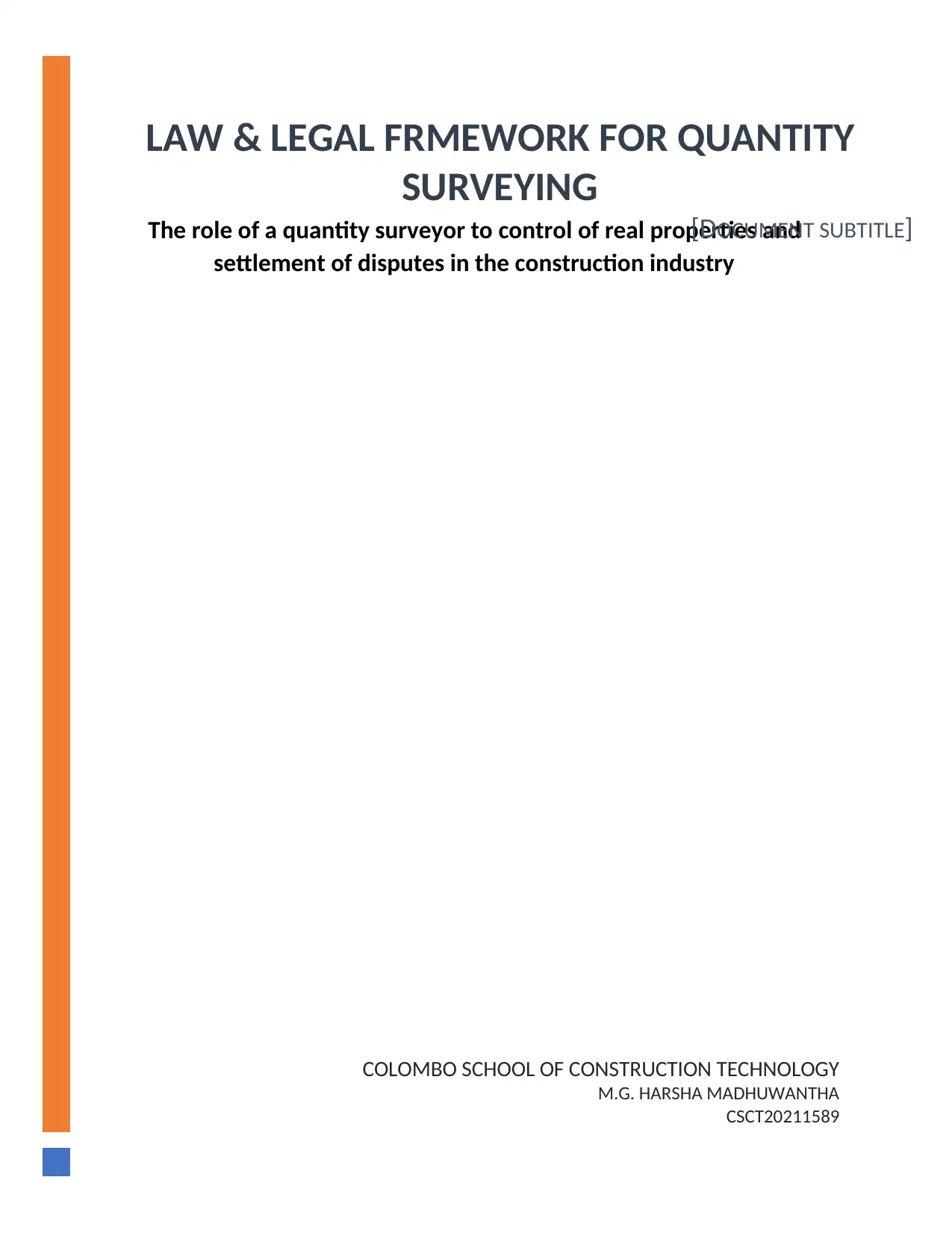
The role of a quantity surveyor to control of real properties and
settlement of disputes in the construction industry
LAW & LEGAL FRMEWORK FOR QUANTITY
SURVEYING [DOCUMENT SUBTITLE]
COLOMBO SCHOOL OF CONSTRUCTION TECHNOLOGY
M.G. HARSHA MADHUWANTHA
CSCT20211589
settlement of disputes in the construction industry
LAW & LEGAL FRMEWORK FOR QUANTITY
SURVEYING [DOCUMENT SUBTITLE]
COLOMBO SCHOOL OF CONSTRUCTION TECHNOLOGY
M.G. HARSHA MADHUWANTHA
CSCT20211589
Paraphrase This Document
Need a fresh take? Get an instant paraphrase of this document with our AI Paraphraser
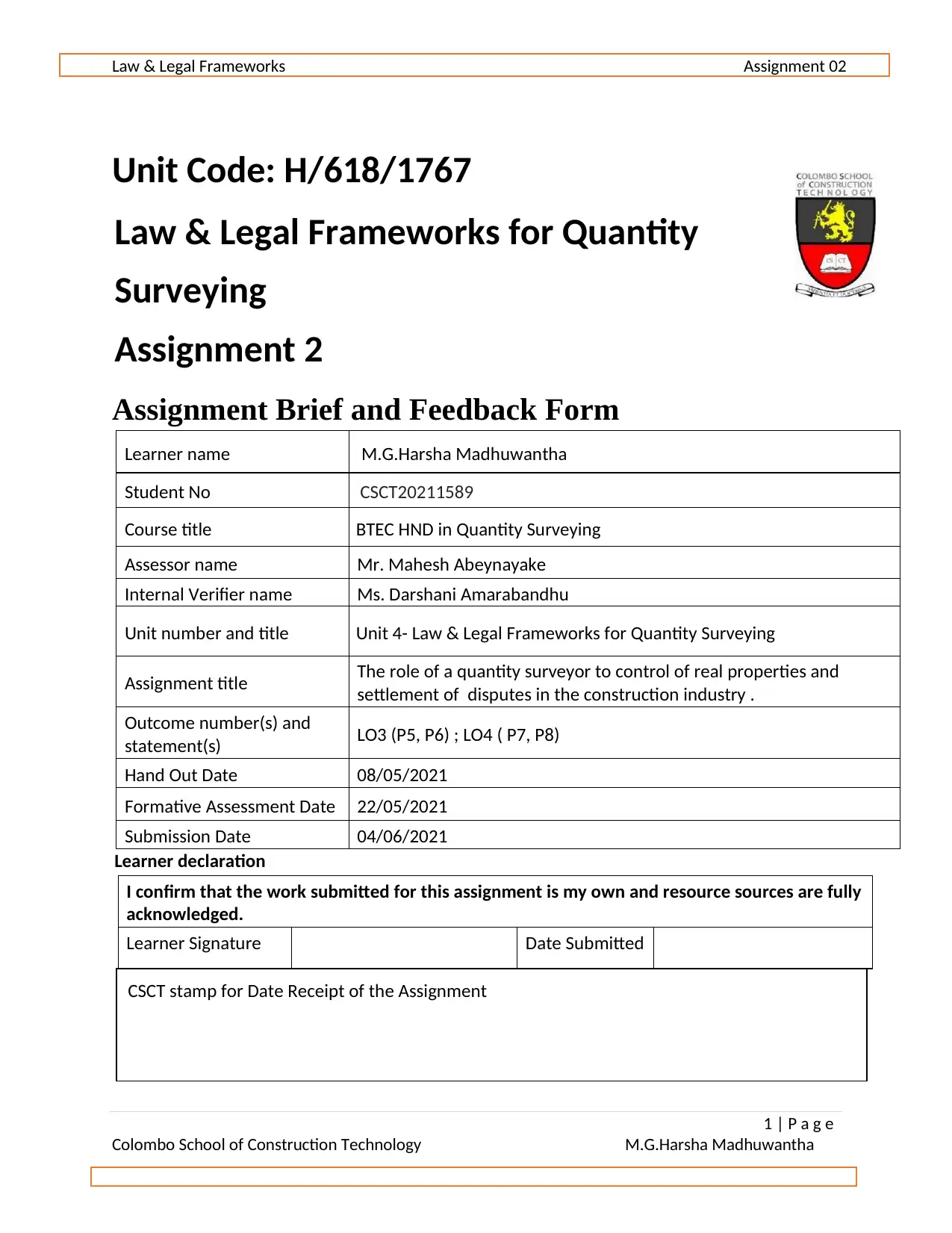
Law & Legal Frameworks Assignment 02
1 | P a g e
Colombo School of Construction Technology M.G.Harsha Madhuwantha
Unit Code: H/618/1767
Law & Legal Frameworks for Quantity
Surveying
Assignment 2
Assignment Brief and Feedback Form
Learner name M.G.Harsha Madhuwantha
Student No CSCT20211589
Course title BTEC HND in Quantity Surveying
Assessor name Mr. Mahesh Abeynayake
Internal Verifier name Ms. Darshani Amarabandhu
Unit number and title Unit 4- Law & Legal Frameworks for Quantity Surveying
Assignment title The role of a quantity surveyor to control of real properties and
settlement of disputes in the construction industry .
Outcome number(s) and
statement(s) LO3 (P5, P6) ; LO4 ( P7, P8)
Hand Out Date 08/05/2021
Formative Assessment Date 22/05/2021
Submission Date 04/06/2021
Learner declaration
I confirm that the work submitted for this assignment is my own and resource sources are fully
acknowledged.
Learner Signature Date Submitted
CSCT stamp for Date Receipt of the Assignment
1 | P a g e
Colombo School of Construction Technology M.G.Harsha Madhuwantha
Unit Code: H/618/1767
Law & Legal Frameworks for Quantity
Surveying
Assignment 2
Assignment Brief and Feedback Form
Learner name M.G.Harsha Madhuwantha
Student No CSCT20211589
Course title BTEC HND in Quantity Surveying
Assessor name Mr. Mahesh Abeynayake
Internal Verifier name Ms. Darshani Amarabandhu
Unit number and title Unit 4- Law & Legal Frameworks for Quantity Surveying
Assignment title The role of a quantity surveyor to control of real properties and
settlement of disputes in the construction industry .
Outcome number(s) and
statement(s) LO3 (P5, P6) ; LO4 ( P7, P8)
Hand Out Date 08/05/2021
Formative Assessment Date 22/05/2021
Submission Date 04/06/2021
Learner declaration
I confirm that the work submitted for this assignment is my own and resource sources are fully
acknowledged.
Learner Signature Date Submitted
CSCT stamp for Date Receipt of the Assignment
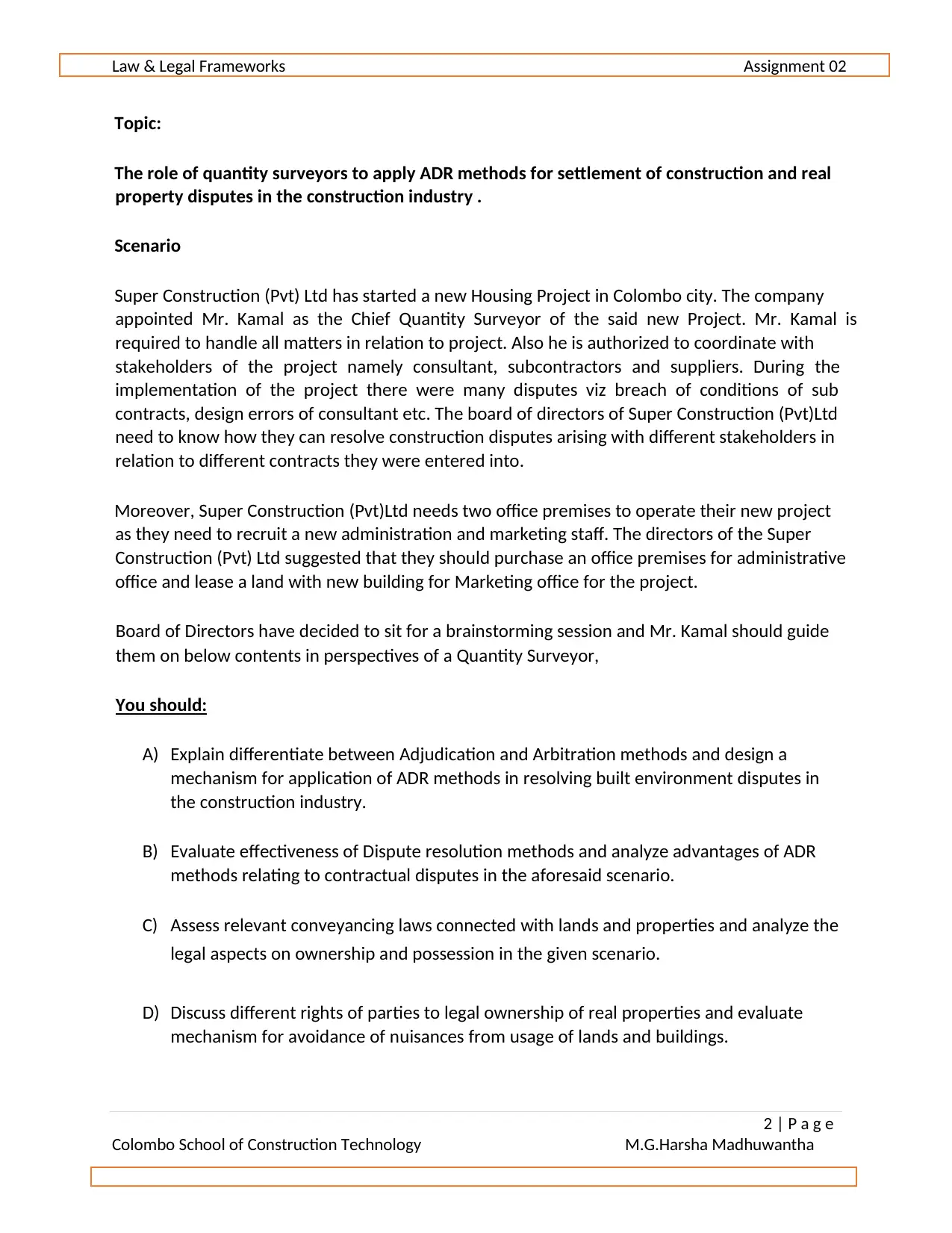
Law & Legal Frameworks Assignment 02
2 | P a g e
Colombo School of Construction Technology M.G.Harsha Madhuwantha
Topic:
The role of quantity surveyors to apply ADR methods for settlement of construction and real
property disputes in the construction industry .
Scenario
Super Construction (Pvt) Ltd has started a new Housing Project in Colombo city. The company
appointed Mr. Kamal as the Chief Quantity Surveyor of the said new Project. Mr. Kamal is
required to handle all matters in relation to project. Also he is authorized to coordinate with
stakeholders of the project namely consultant, subcontractors and suppliers. During the
implementation of the project there were many disputes viz breach of conditions of sub
contracts, design errors of consultant etc. The board of directors of Super Construction (Pvt)Ltd
need to know how they can resolve construction disputes arising with different stakeholders in
relation to different contracts they were entered into.
Moreover, Super Construction (Pvt)Ltd needs two office premises to operate their new project
as they need to recruit a new administration and marketing staff. The directors of the Super
Construction (Pvt) Ltd suggested that they should purchase an office premises for administrative
office and lease a land with new building for Marketing office for the project.
Board of Directors have decided to sit for a brainstorming session and Mr. Kamal should guide
them on below contents in perspectives of a Quantity Surveyor,
You should:
A) Explain differentiate between Adjudication and Arbitration methods and design a
mechanism for application of ADR methods in resolving built environment disputes in
the construction industry.
B) Evaluate effectiveness of Dispute resolution methods and analyze advantages of ADR
methods relating to contractual disputes in the aforesaid scenario.
C) Assess relevant conveyancing laws connected with lands and properties and analyze the
legal aspects on ownership and possession in the given scenario.
D) Discuss different rights of parties to legal ownership of real properties and evaluate
mechanism for avoidance of nuisances from usage of lands and buildings.
2 | P a g e
Colombo School of Construction Technology M.G.Harsha Madhuwantha
Topic:
The role of quantity surveyors to apply ADR methods for settlement of construction and real
property disputes in the construction industry .
Scenario
Super Construction (Pvt) Ltd has started a new Housing Project in Colombo city. The company
appointed Mr. Kamal as the Chief Quantity Surveyor of the said new Project. Mr. Kamal is
required to handle all matters in relation to project. Also he is authorized to coordinate with
stakeholders of the project namely consultant, subcontractors and suppliers. During the
implementation of the project there were many disputes viz breach of conditions of sub
contracts, design errors of consultant etc. The board of directors of Super Construction (Pvt)Ltd
need to know how they can resolve construction disputes arising with different stakeholders in
relation to different contracts they were entered into.
Moreover, Super Construction (Pvt)Ltd needs two office premises to operate their new project
as they need to recruit a new administration and marketing staff. The directors of the Super
Construction (Pvt) Ltd suggested that they should purchase an office premises for administrative
office and lease a land with new building for Marketing office for the project.
Board of Directors have decided to sit for a brainstorming session and Mr. Kamal should guide
them on below contents in perspectives of a Quantity Surveyor,
You should:
A) Explain differentiate between Adjudication and Arbitration methods and design a
mechanism for application of ADR methods in resolving built environment disputes in
the construction industry.
B) Evaluate effectiveness of Dispute resolution methods and analyze advantages of ADR
methods relating to contractual disputes in the aforesaid scenario.
C) Assess relevant conveyancing laws connected with lands and properties and analyze the
legal aspects on ownership and possession in the given scenario.
D) Discuss different rights of parties to legal ownership of real properties and evaluate
mechanism for avoidance of nuisances from usage of lands and buildings.
⊘ This is a preview!⊘
Do you want full access?
Subscribe today to unlock all pages.

Trusted by 1+ million students worldwide
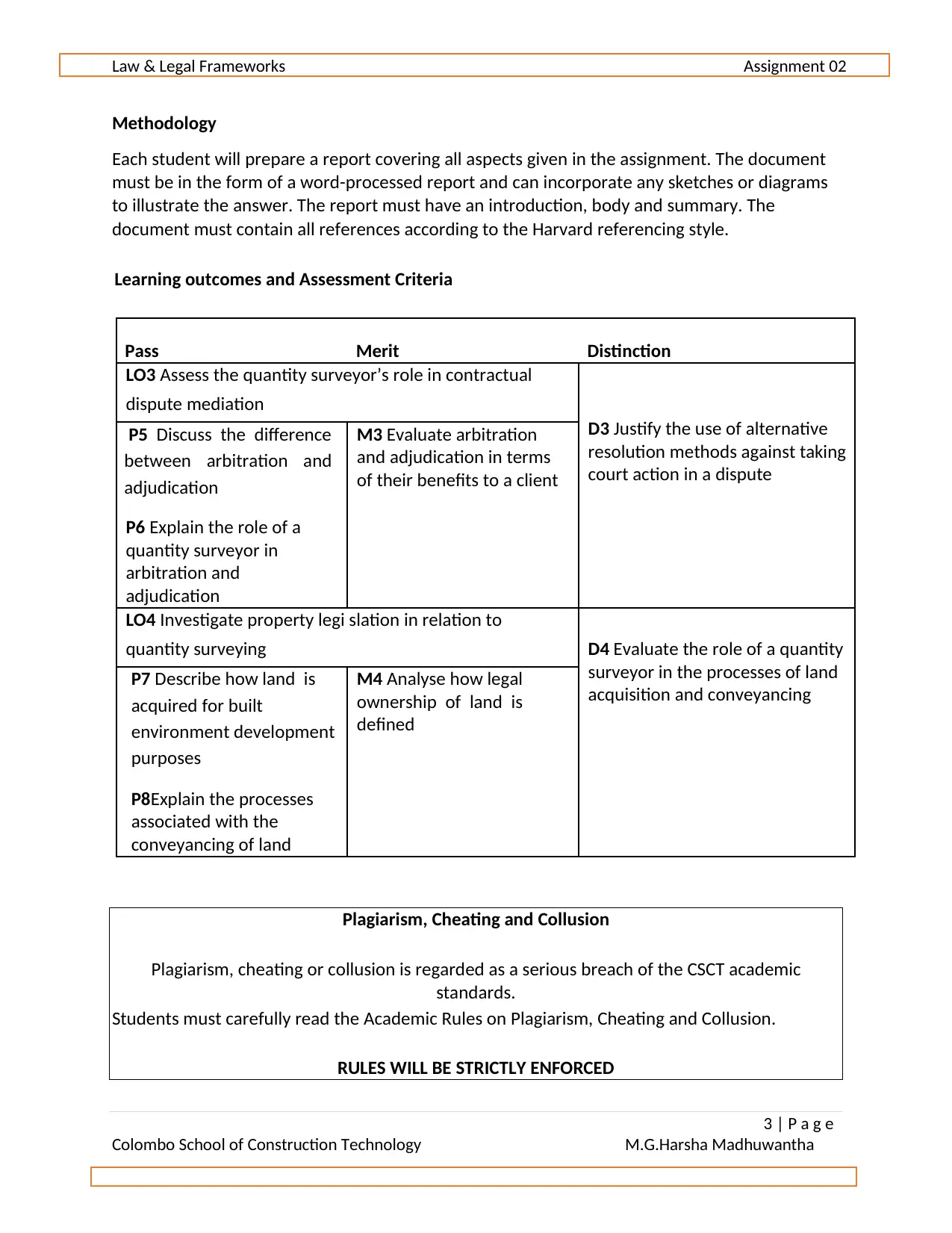
Law & Legal Frameworks Assignment 02
3 | P a g e
Colombo School of Construction Technology M.G.Harsha Madhuwantha
Methodology
Each student will prepare a report covering all aspects given in the assignment. The document
must be in the form of a word-processed report and can incorporate any sketches or diagrams
to illustrate the answer. The report must have an introduction, body and summary. The
document must contain all references according to the Harvard referencing style.
Learning outcomes and Assessment Criteria
Pass Merit Distinction
LO3 Assess the quantity surveyor’s role in contractual
dispute mediation
D3 Justify the use of alternative
resolution methods against taking
court action in a dispute
P5 Discuss the difference
between arbitration and
adjudication
P6 Explain the role of a
quantity surveyor in
arbitration and
adjudication
M3 Evaluate arbitration
and adjudication in terms
of their benefits to a client
LO4 Investigate property legi slation in relation to
quantity surveying D4 Evaluate the role of a quantity
surveyor in the processes of land
acquisition and conveyancing
P7 Describe how land is
acquired for built
environment development
purposes
P8Explain the processes
associated with the
conveyancing of land
M4 Analyse how legal
ownership of land is
defined
Plagiarism, Cheating and Collusion
Plagiarism, cheating or collusion is regarded as a serious breach of the CSCT academic
standards.
Students must carefully read the Academic Rules on Plagiarism, Cheating and Collusion.
RULES WILL BE STRICTLY ENFORCED
3 | P a g e
Colombo School of Construction Technology M.G.Harsha Madhuwantha
Methodology
Each student will prepare a report covering all aspects given in the assignment. The document
must be in the form of a word-processed report and can incorporate any sketches or diagrams
to illustrate the answer. The report must have an introduction, body and summary. The
document must contain all references according to the Harvard referencing style.
Learning outcomes and Assessment Criteria
Pass Merit Distinction
LO3 Assess the quantity surveyor’s role in contractual
dispute mediation
D3 Justify the use of alternative
resolution methods against taking
court action in a dispute
P5 Discuss the difference
between arbitration and
adjudication
P6 Explain the role of a
quantity surveyor in
arbitration and
adjudication
M3 Evaluate arbitration
and adjudication in terms
of their benefits to a client
LO4 Investigate property legi slation in relation to
quantity surveying D4 Evaluate the role of a quantity
surveyor in the processes of land
acquisition and conveyancing
P7 Describe how land is
acquired for built
environment development
purposes
P8Explain the processes
associated with the
conveyancing of land
M4 Analyse how legal
ownership of land is
defined
Plagiarism, Cheating and Collusion
Plagiarism, cheating or collusion is regarded as a serious breach of the CSCT academic
standards.
Students must carefully read the Academic Rules on Plagiarism, Cheating and Collusion.
RULES WILL BE STRICTLY ENFORCED
Paraphrase This Document
Need a fresh take? Get an instant paraphrase of this document with our AI Paraphraser
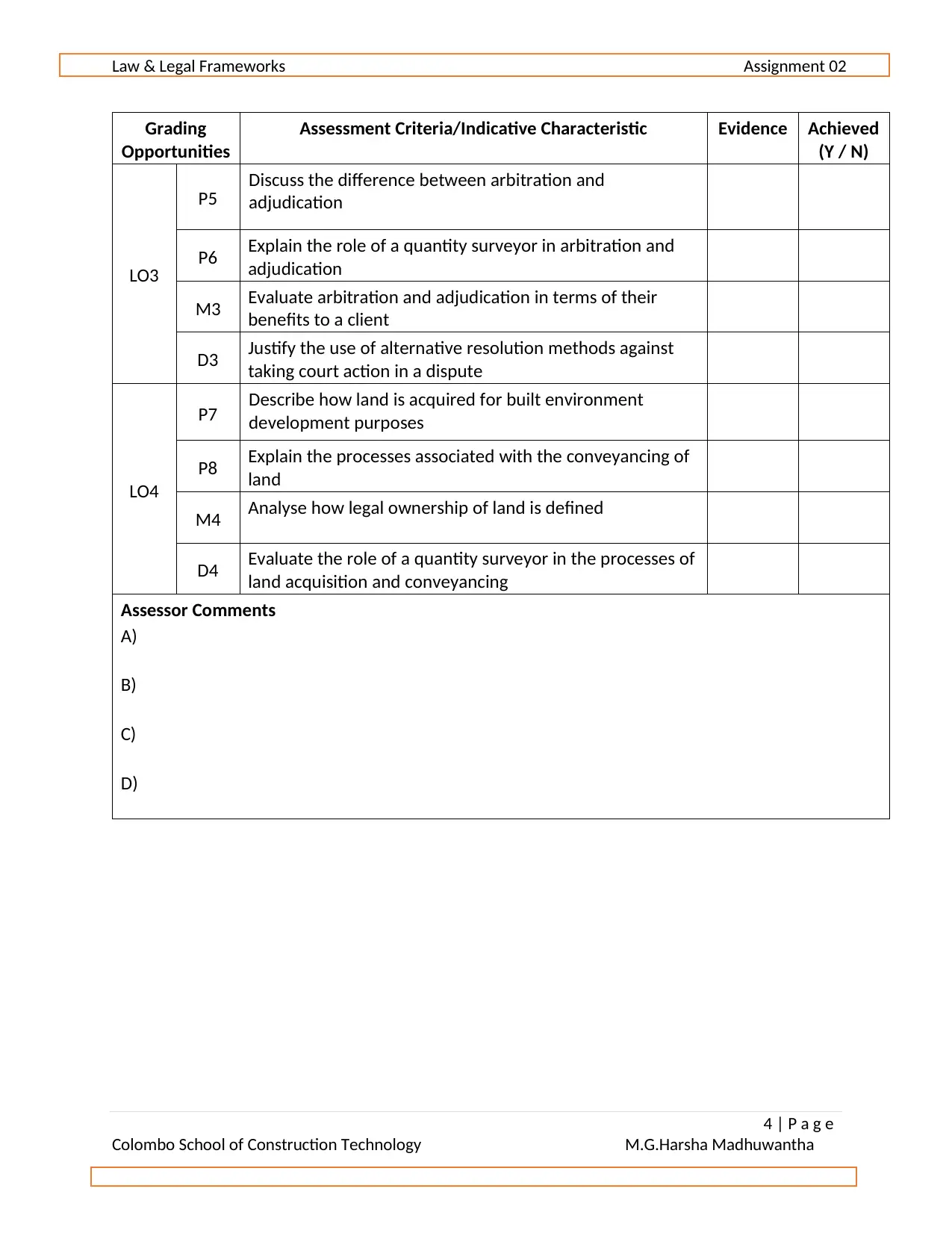
Law & Legal Frameworks Assignment 02
4 | P a g e
Colombo School of Construction Technology M.G.Harsha Madhuwantha
Grading
Opportunities
Assessment Criteria/Indicative Characteristic Evidence Achieved
(Y / N)
LO3
P5
Discuss the difference between arbitration and
adjudication
P6 Explain the role of a quantity surveyor in arbitration and
adjudication
M3 Evaluate arbitration and adjudication in terms of their
benefits to a client
D3 Justify the use of alternative resolution methods against
taking court action in a dispute
LO4
P7 Describe how land is acquired for built environment
development purposes
P8 Explain the processes associated with the conveyancing of
land
M4 Analyse how legal ownership of land is defined
D4 Evaluate the role of a quantity surveyor in the processes of
land acquisition and conveyancing
Assessor Comments
A)
B)
C)
D)
4 | P a g e
Colombo School of Construction Technology M.G.Harsha Madhuwantha
Grading
Opportunities
Assessment Criteria/Indicative Characteristic Evidence Achieved
(Y / N)
LO3
P5
Discuss the difference between arbitration and
adjudication
P6 Explain the role of a quantity surveyor in arbitration and
adjudication
M3 Evaluate arbitration and adjudication in terms of their
benefits to a client
D3 Justify the use of alternative resolution methods against
taking court action in a dispute
LO4
P7 Describe how land is acquired for built environment
development purposes
P8 Explain the processes associated with the conveyancing of
land
M4 Analyse how legal ownership of land is defined
D4 Evaluate the role of a quantity surveyor in the processes of
land acquisition and conveyancing
Assessor Comments
A)
B)
C)
D)
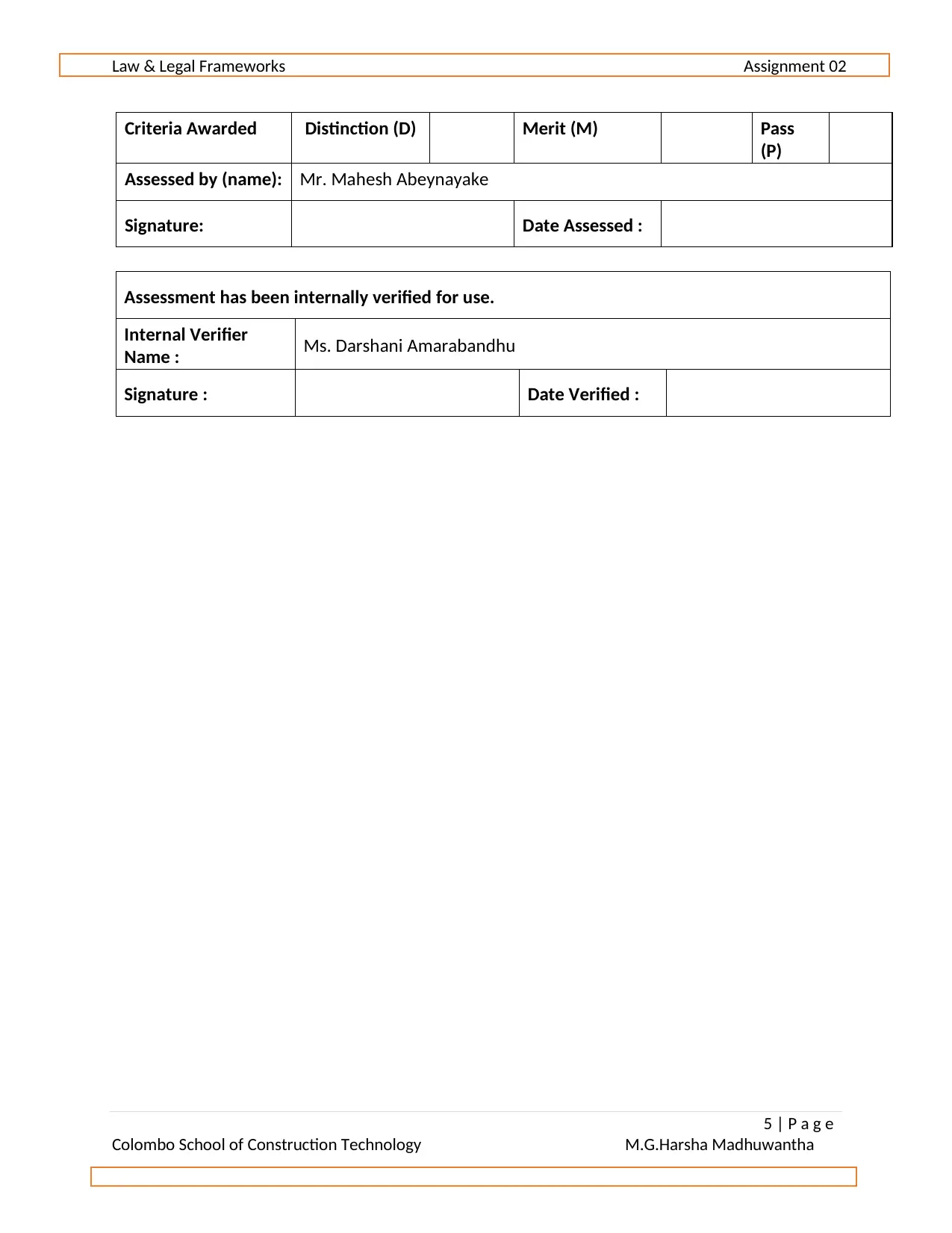
Law & Legal Frameworks Assignment 02
5 | P a g e
Colombo School of Construction Technology M.G.Harsha Madhuwantha
Criteria Awarded Distinction (D) Merit (M) Pass
(P)
Assessed by (name): Mr. Mahesh Abeynayake
Signature: Date Assessed :
Assessment has been internally verified for use.
Internal Verifier
Name : Ms. Darshani Amarabandhu
Signature : Date Verified :
5 | P a g e
Colombo School of Construction Technology M.G.Harsha Madhuwantha
Criteria Awarded Distinction (D) Merit (M) Pass
(P)
Assessed by (name): Mr. Mahesh Abeynayake
Signature: Date Assessed :
Assessment has been internally verified for use.
Internal Verifier
Name : Ms. Darshani Amarabandhu
Signature : Date Verified :
⊘ This is a preview!⊘
Do you want full access?
Subscribe today to unlock all pages.

Trusted by 1+ million students worldwide
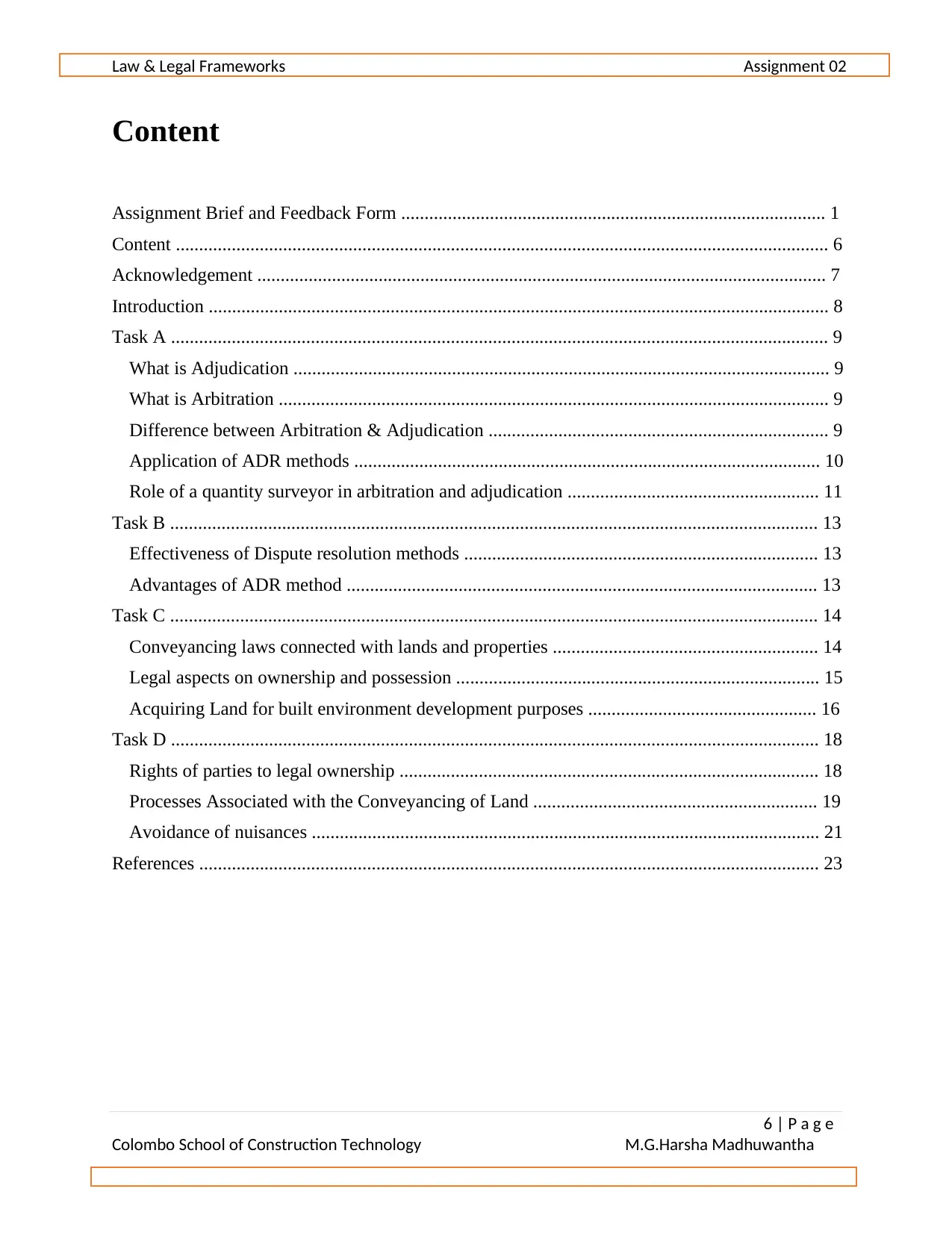
Law & Legal Frameworks Assignment 02
6 | P a g e
Colombo School of Construction Technology M.G.Harsha Madhuwantha
Content
Assignment Brief and Feedback Form ........................................................................................... 1
Content ............................................................................................................................................ 6
Acknowledgement .......................................................................................................................... 7
Introduction ..................................................................................................................................... 8
Task A ............................................................................................................................................. 9
What is Adjudication ................................................................................................................... 9
What is Arbitration ...................................................................................................................... 9
Difference between Arbitration & Adjudication ......................................................................... 9
Application of ADR methods .................................................................................................... 10
Role of a quantity surveyor in arbitration and adjudication ...................................................... 11
Task B ........................................................................................................................................... 13
Effectiveness of Dispute resolution methods ............................................................................ 13
Advantages of ADR method ..................................................................................................... 13
Task C ........................................................................................................................................... 14
Conveyancing laws connected with lands and properties ......................................................... 14
Legal aspects on ownership and possession .............................................................................. 15
Acquiring Land for built environment development purposes ................................................. 16
Task D ........................................................................................................................................... 18
Rights of parties to legal ownership .......................................................................................... 18
Processes Associated with the Conveyancing of Land ............................................................. 19
Avoidance of nuisances ............................................................................................................. 21
References ..................................................................................................................................... 23
6 | P a g e
Colombo School of Construction Technology M.G.Harsha Madhuwantha
Content
Assignment Brief and Feedback Form ........................................................................................... 1
Content ............................................................................................................................................ 6
Acknowledgement .......................................................................................................................... 7
Introduction ..................................................................................................................................... 8
Task A ............................................................................................................................................. 9
What is Adjudication ................................................................................................................... 9
What is Arbitration ...................................................................................................................... 9
Difference between Arbitration & Adjudication ......................................................................... 9
Application of ADR methods .................................................................................................... 10
Role of a quantity surveyor in arbitration and adjudication ...................................................... 11
Task B ........................................................................................................................................... 13
Effectiveness of Dispute resolution methods ............................................................................ 13
Advantages of ADR method ..................................................................................................... 13
Task C ........................................................................................................................................... 14
Conveyancing laws connected with lands and properties ......................................................... 14
Legal aspects on ownership and possession .............................................................................. 15
Acquiring Land for built environment development purposes ................................................. 16
Task D ........................................................................................................................................... 18
Rights of parties to legal ownership .......................................................................................... 18
Processes Associated with the Conveyancing of Land ............................................................. 19
Avoidance of nuisances ............................................................................................................. 21
References ..................................................................................................................................... 23
Paraphrase This Document
Need a fresh take? Get an instant paraphrase of this document with our AI Paraphraser
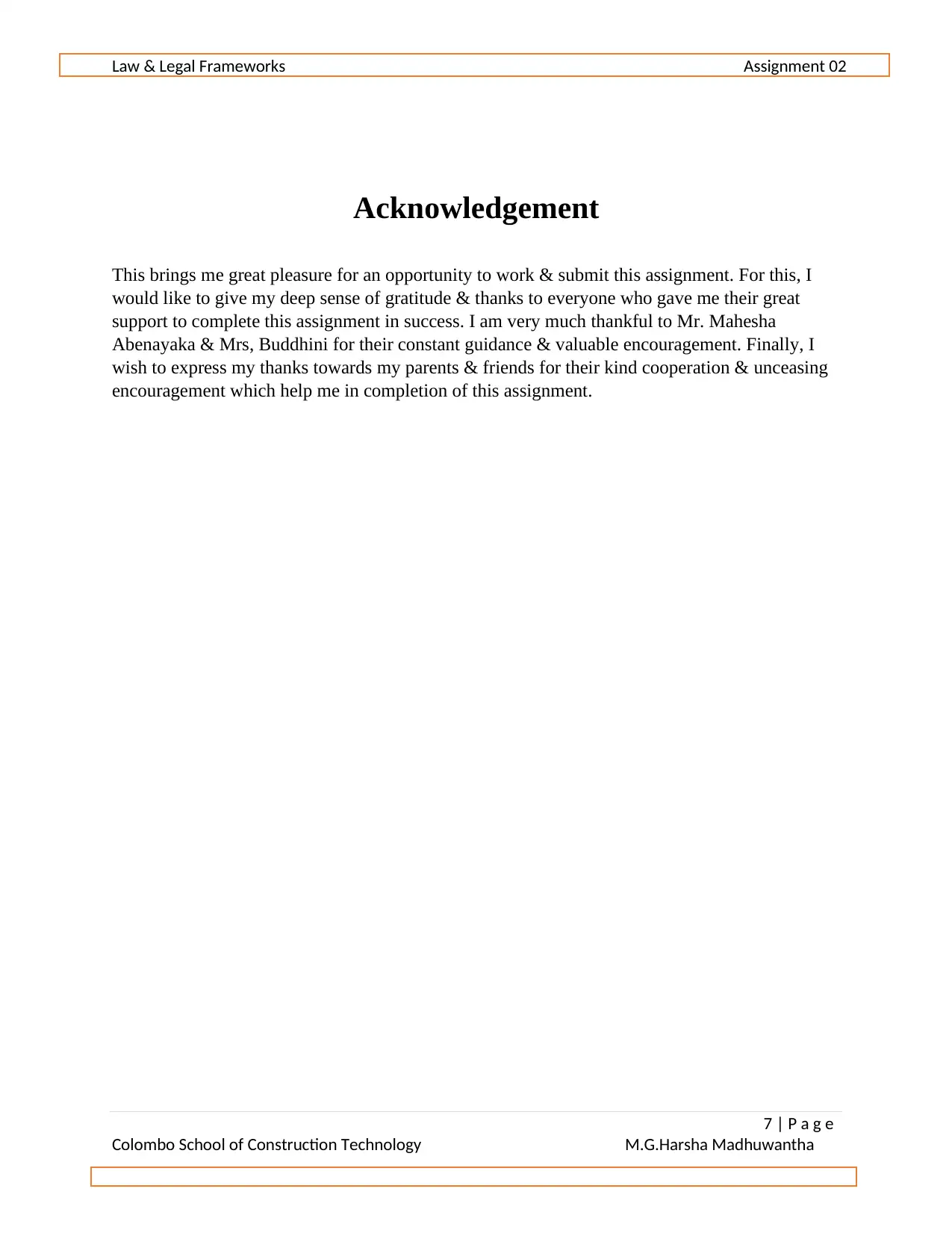
Law & Legal Frameworks Assignment 02
7 | P a g e
Colombo School of Construction Technology M.G.Harsha Madhuwantha
Acknowledgement
This brings me great pleasure for an opportunity to work & submit this assignment. For this, I
would like to give my deep sense of gratitude & thanks to everyone who gave me their great
support to complete this assignment in success. I am very much thankful to Mr. Mahesha
Abenayaka & Mrs, Buddhini for their constant guidance & valuable encouragement. Finally, I
wish to express my thanks towards my parents & friends for their kind cooperation & unceasing
encouragement which help me in completion of this assignment.
7 | P a g e
Colombo School of Construction Technology M.G.Harsha Madhuwantha
Acknowledgement
This brings me great pleasure for an opportunity to work & submit this assignment. For this, I
would like to give my deep sense of gratitude & thanks to everyone who gave me their great
support to complete this assignment in success. I am very much thankful to Mr. Mahesha
Abenayaka & Mrs, Buddhini for their constant guidance & valuable encouragement. Finally, I
wish to express my thanks towards my parents & friends for their kind cooperation & unceasing
encouragement which help me in completion of this assignment.
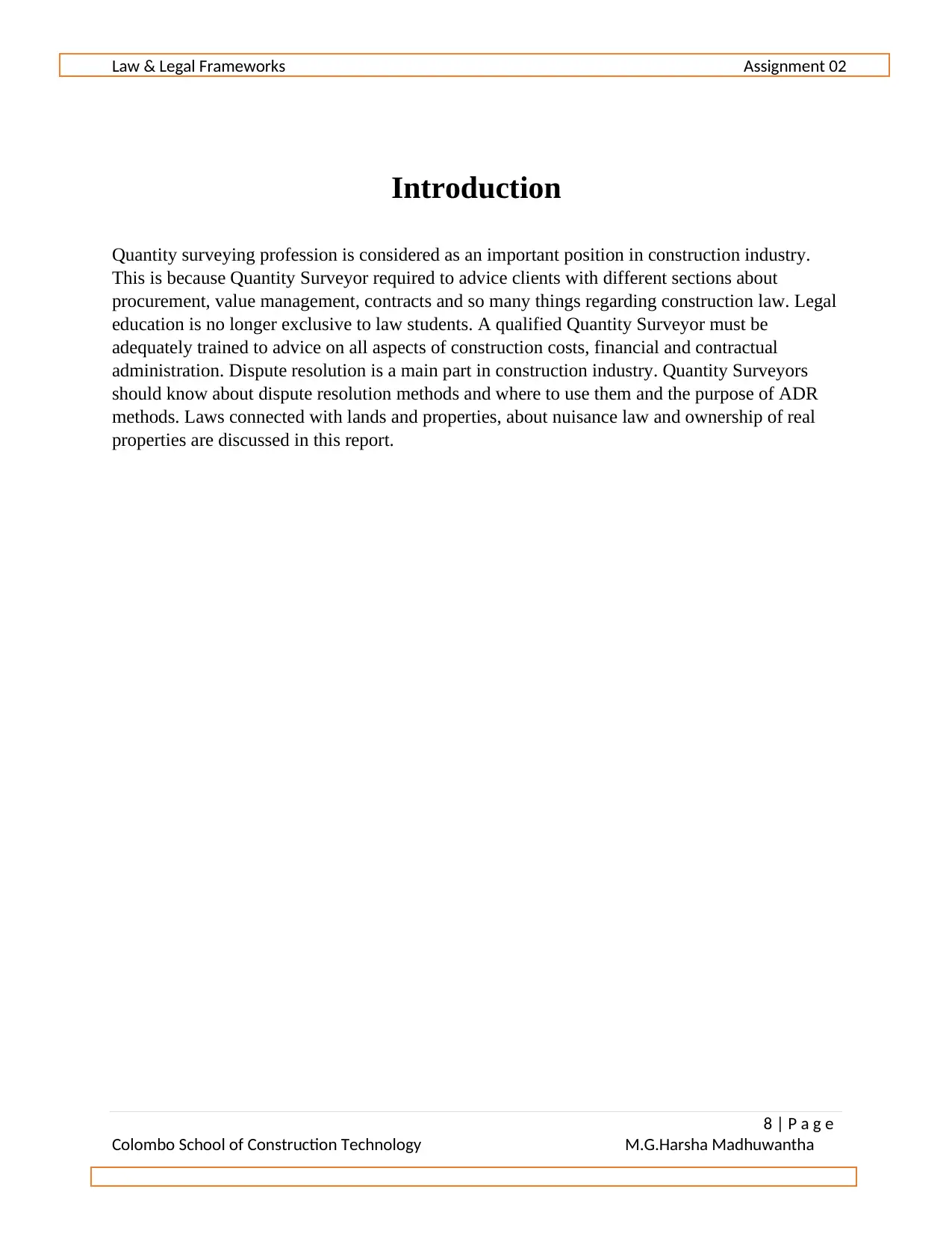
Law & Legal Frameworks Assignment 02
8 | P a g e
Colombo School of Construction Technology M.G.Harsha Madhuwantha
Introduction
Quantity surveying profession is considered as an important position in construction industry.
This is because Quantity Surveyor required to advice clients with different sections about
procurement, value management, contracts and so many things regarding construction law. Legal
education is no longer exclusive to law students. A qualified Quantity Surveyor must be
adequately trained to advice on all aspects of construction costs, financial and contractual
administration. Dispute resolution is a main part in construction industry. Quantity Surveyors
should know about dispute resolution methods and where to use them and the purpose of ADR
methods. Laws connected with lands and properties, about nuisance law and ownership of real
properties are discussed in this report.
8 | P a g e
Colombo School of Construction Technology M.G.Harsha Madhuwantha
Introduction
Quantity surveying profession is considered as an important position in construction industry.
This is because Quantity Surveyor required to advice clients with different sections about
procurement, value management, contracts and so many things regarding construction law. Legal
education is no longer exclusive to law students. A qualified Quantity Surveyor must be
adequately trained to advice on all aspects of construction costs, financial and contractual
administration. Dispute resolution is a main part in construction industry. Quantity Surveyors
should know about dispute resolution methods and where to use them and the purpose of ADR
methods. Laws connected with lands and properties, about nuisance law and ownership of real
properties are discussed in this report.
⊘ This is a preview!⊘
Do you want full access?
Subscribe today to unlock all pages.

Trusted by 1+ million students worldwide
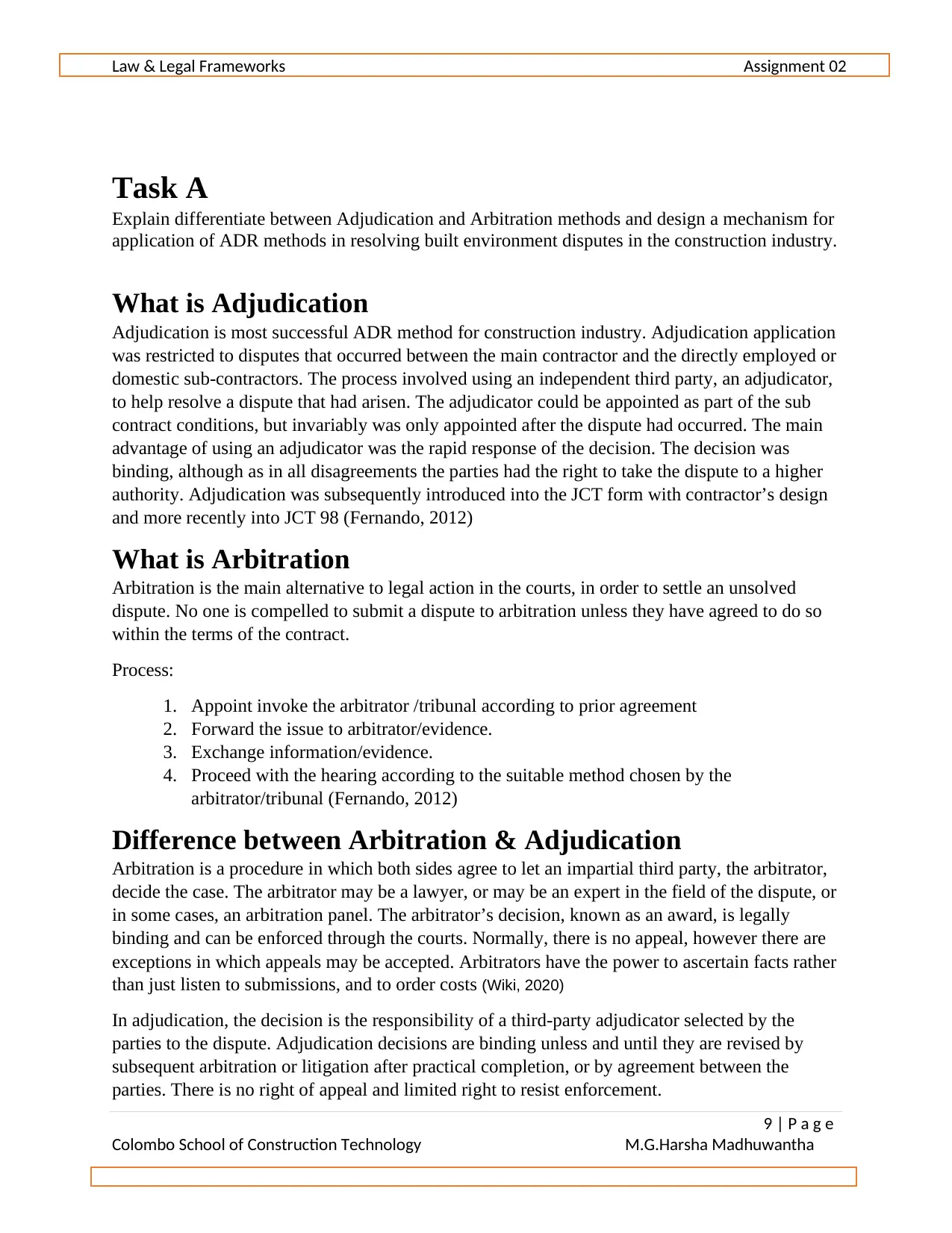
Law & Legal Frameworks Assignment 02
9 | P a g e
Colombo School of Construction Technology M.G.Harsha Madhuwantha
Task A
Explain differentiate between Adjudication and Arbitration methods and design a mechanism for
application of ADR methods in resolving built environment disputes in the construction industry.
What is Adjudication
Adjudication is most successful ADR method for construction industry. Adjudication application
was restricted to disputes that occurred between the main contractor and the directly employed or
domestic sub-contractors. The process involved using an independent third party, an adjudicator,
to help resolve a dispute that had arisen. The adjudicator could be appointed as part of the sub
contract conditions, but invariably was only appointed after the dispute had occurred. The main
advantage of using an adjudicator was the rapid response of the decision. The decision was
binding, although as in all disagreements the parties had the right to take the dispute to a higher
authority. Adjudication was subsequently introduced into the JCT form with contractor’s design
and more recently into JCT 98 (Fernando, 2012)
What is Arbitration
Arbitration is the main alternative to legal action in the courts, in order to settle an unsolved
dispute. No one is compelled to submit a dispute to arbitration unless they have agreed to do so
within the terms of the contract.
Process:
1. Appoint invoke the arbitrator /tribunal according to prior agreement
2. Forward the issue to arbitrator/evidence.
3. Exchange information/evidence.
4. Proceed with the hearing according to the suitable method chosen by the
arbitrator/tribunal (Fernando, 2012)
Difference between Arbitration & Adjudication
Arbitration is a procedure in which both sides agree to let an impartial third party, the arbitrator,
decide the case. The arbitrator may be a lawyer, or may be an expert in the field of the dispute, or
in some cases, an arbitration panel. The arbitrator’s decision, known as an award, is legally
binding and can be enforced through the courts. Normally, there is no appeal, however there are
exceptions in which appeals may be accepted. Arbitrators have the power to ascertain facts rather
than just listen to submissions, and to order costs (Wiki, 2020)
In adjudication, the decision is the responsibility of a third-party adjudicator selected by the
parties to the dispute. Adjudication decisions are binding unless and until they are revised by
subsequent arbitration or litigation after practical completion, or by agreement between the
parties. There is no right of appeal and limited right to resist enforcement.
9 | P a g e
Colombo School of Construction Technology M.G.Harsha Madhuwantha
Task A
Explain differentiate between Adjudication and Arbitration methods and design a mechanism for
application of ADR methods in resolving built environment disputes in the construction industry.
What is Adjudication
Adjudication is most successful ADR method for construction industry. Adjudication application
was restricted to disputes that occurred between the main contractor and the directly employed or
domestic sub-contractors. The process involved using an independent third party, an adjudicator,
to help resolve a dispute that had arisen. The adjudicator could be appointed as part of the sub
contract conditions, but invariably was only appointed after the dispute had occurred. The main
advantage of using an adjudicator was the rapid response of the decision. The decision was
binding, although as in all disagreements the parties had the right to take the dispute to a higher
authority. Adjudication was subsequently introduced into the JCT form with contractor’s design
and more recently into JCT 98 (Fernando, 2012)
What is Arbitration
Arbitration is the main alternative to legal action in the courts, in order to settle an unsolved
dispute. No one is compelled to submit a dispute to arbitration unless they have agreed to do so
within the terms of the contract.
Process:
1. Appoint invoke the arbitrator /tribunal according to prior agreement
2. Forward the issue to arbitrator/evidence.
3. Exchange information/evidence.
4. Proceed with the hearing according to the suitable method chosen by the
arbitrator/tribunal (Fernando, 2012)
Difference between Arbitration & Adjudication
Arbitration is a procedure in which both sides agree to let an impartial third party, the arbitrator,
decide the case. The arbitrator may be a lawyer, or may be an expert in the field of the dispute, or
in some cases, an arbitration panel. The arbitrator’s decision, known as an award, is legally
binding and can be enforced through the courts. Normally, there is no appeal, however there are
exceptions in which appeals may be accepted. Arbitrators have the power to ascertain facts rather
than just listen to submissions, and to order costs (Wiki, 2020)
In adjudication, the decision is the responsibility of a third-party adjudicator selected by the
parties to the dispute. Adjudication decisions are binding unless and until they are revised by
subsequent arbitration or litigation after practical completion, or by agreement between the
parties. There is no right of appeal and limited right to resist enforcement.
Paraphrase This Document
Need a fresh take? Get an instant paraphrase of this document with our AI Paraphraser
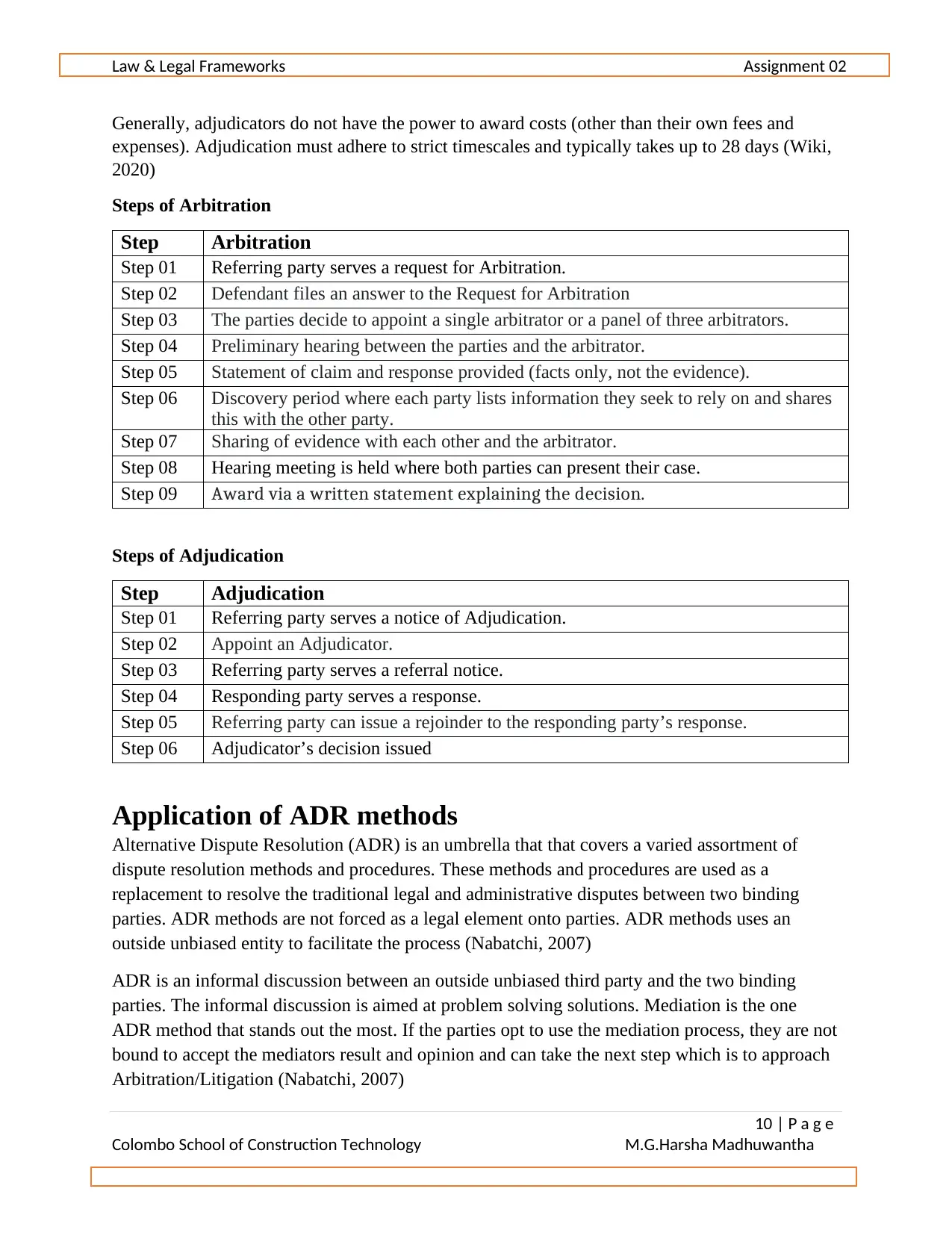
Law & Legal Frameworks Assignment 02
10 | P a g e
Colombo School of Construction Technology M.G.Harsha Madhuwantha
Generally, adjudicators do not have the power to award costs (other than their own fees and
expenses). Adjudication must adhere to strict timescales and typically takes up to 28 days (Wiki,
2020)
Steps of Arbitration
Step Arbitration
Step 01 Referring party serves a request for Arbitration.
Step 02 Defendant files an answer to the Request for Arbitration
Step 03 The parties decide to appoint a single arbitrator or a panel of three arbitrators.
Step 04 Preliminary hearing between the parties and the arbitrator.
Step 05 Statement of claim and response provided (facts only, not the evidence).
Step 06 Discovery period where each party lists information they seek to rely on and shares
this with the other party.
Step 07 Sharing of evidence with each other and the arbitrator.
Step 08 Hearing meeting is held where both parties can present their case.
Step 09 Award via a written statement explaining the decision.
Steps of Adjudication
Step Adjudication
Step 01 Referring party serves a notice of Adjudication.
Step 02 Appoint an Adjudicator.
Step 03 Referring party serves a referral notice.
Step 04 Responding party serves a response.
Step 05 Referring party can issue a rejoinder to the responding party’s response.
Step 06 Adjudicator’s decision issued
Application of ADR methods
Alternative Dispute Resolution (ADR) is an umbrella that that covers a varied assortment of
dispute resolution methods and procedures. These methods and procedures are used as a
replacement to resolve the traditional legal and administrative disputes between two binding
parties. ADR methods are not forced as a legal element onto parties. ADR methods uses an
outside unbiased entity to facilitate the process (Nabatchi, 2007)
ADR is an informal discussion between an outside unbiased third party and the two binding
parties. The informal discussion is aimed at problem solving solutions. Mediation is the one
ADR method that stands out the most. If the parties opt to use the mediation process, they are not
bound to accept the mediators result and opinion and can take the next step which is to approach
Arbitration/Litigation (Nabatchi, 2007)
10 | P a g e
Colombo School of Construction Technology M.G.Harsha Madhuwantha
Generally, adjudicators do not have the power to award costs (other than their own fees and
expenses). Adjudication must adhere to strict timescales and typically takes up to 28 days (Wiki,
2020)
Steps of Arbitration
Step Arbitration
Step 01 Referring party serves a request for Arbitration.
Step 02 Defendant files an answer to the Request for Arbitration
Step 03 The parties decide to appoint a single arbitrator or a panel of three arbitrators.
Step 04 Preliminary hearing between the parties and the arbitrator.
Step 05 Statement of claim and response provided (facts only, not the evidence).
Step 06 Discovery period where each party lists information they seek to rely on and shares
this with the other party.
Step 07 Sharing of evidence with each other and the arbitrator.
Step 08 Hearing meeting is held where both parties can present their case.
Step 09 Award via a written statement explaining the decision.
Steps of Adjudication
Step Adjudication
Step 01 Referring party serves a notice of Adjudication.
Step 02 Appoint an Adjudicator.
Step 03 Referring party serves a referral notice.
Step 04 Responding party serves a response.
Step 05 Referring party can issue a rejoinder to the responding party’s response.
Step 06 Adjudicator’s decision issued
Application of ADR methods
Alternative Dispute Resolution (ADR) is an umbrella that that covers a varied assortment of
dispute resolution methods and procedures. These methods and procedures are used as a
replacement to resolve the traditional legal and administrative disputes between two binding
parties. ADR methods are not forced as a legal element onto parties. ADR methods uses an
outside unbiased entity to facilitate the process (Nabatchi, 2007)
ADR is an informal discussion between an outside unbiased third party and the two binding
parties. The informal discussion is aimed at problem solving solutions. Mediation is the one
ADR method that stands out the most. If the parties opt to use the mediation process, they are not
bound to accept the mediators result and opinion and can take the next step which is to approach
Arbitration/Litigation (Nabatchi, 2007)
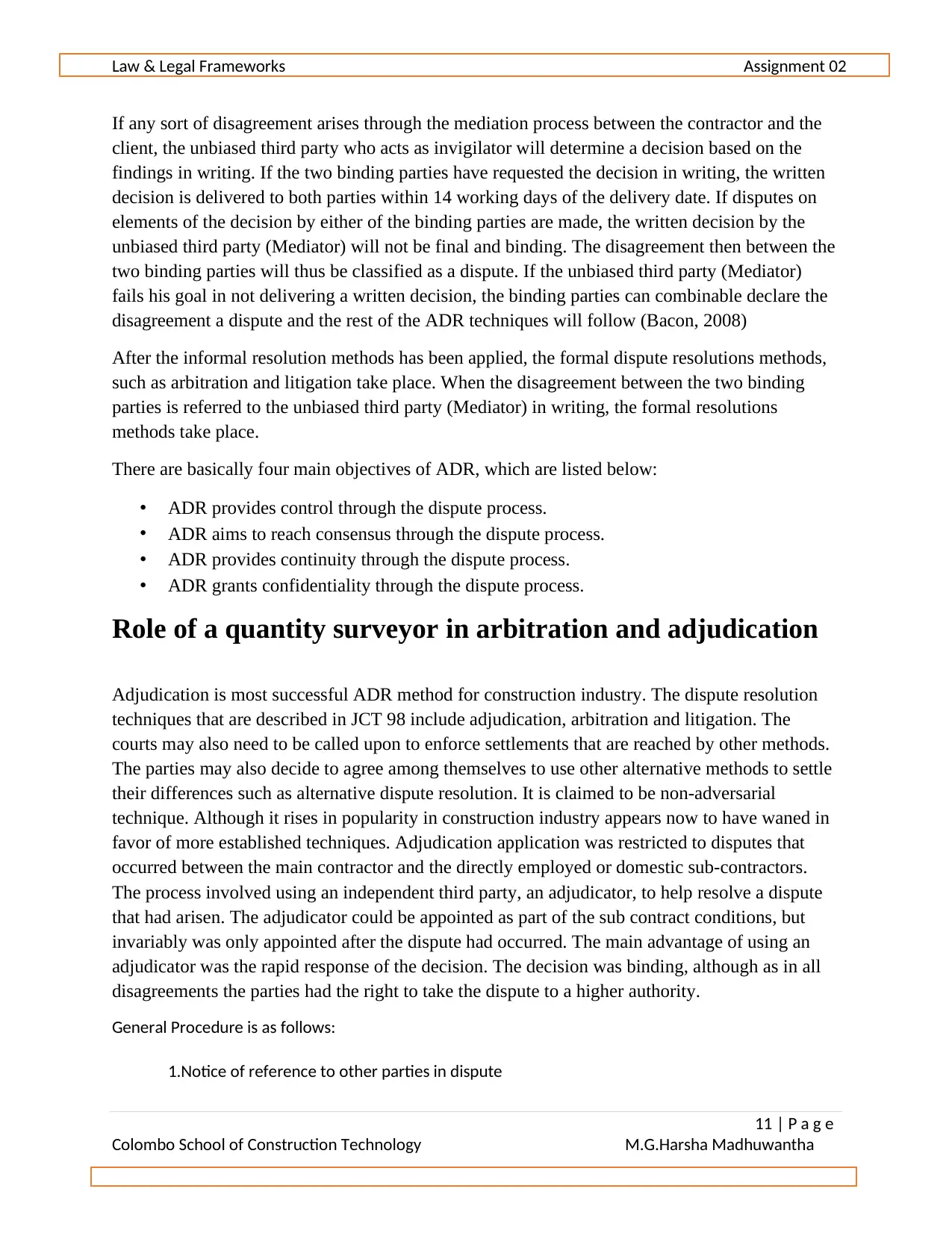
Law & Legal Frameworks Assignment 02
11 | P a g e
Colombo School of Construction Technology M.G.Harsha Madhuwantha
If any sort of disagreement arises through the mediation process between the contractor and the
client, the unbiased third party who acts as invigilator will determine a decision based on the
findings in writing. If the two binding parties have requested the decision in writing, the written
decision is delivered to both parties within 14 working days of the delivery date. If disputes on
elements of the decision by either of the binding parties are made, the written decision by the
unbiased third party (Mediator) will not be final and binding. The disagreement then between the
two binding parties will thus be classified as a dispute. If the unbiased third party (Mediator)
fails his goal in not delivering a written decision, the binding parties can combinable declare the
disagreement a dispute and the rest of the ADR techniques will follow (Bacon, 2008)
After the informal resolution methods has been applied, the formal dispute resolutions methods,
such as arbitration and litigation take place. When the disagreement between the two binding
parties is referred to the unbiased third party (Mediator) in writing, the formal resolutions
methods take place.
There are basically four main objectives of ADR, which are listed below:
• ADR provides control through the dispute process.
• ADR aims to reach consensus through the dispute process.
• ADR provides continuity through the dispute process.
• ADR grants confidentiality through the dispute process.
Role of a quantity surveyor in arbitration and adjudication
Adjudication is most successful ADR method for construction industry. The dispute resolution
techniques that are described in JCT 98 include adjudication, arbitration and litigation. The
courts may also need to be called upon to enforce settlements that are reached by other methods.
The parties may also decide to agree among themselves to use other alternative methods to settle
their differences such as alternative dispute resolution. It is claimed to be non-adversarial
technique. Although it rises in popularity in construction industry appears now to have waned in
favor of more established techniques. Adjudication application was restricted to disputes that
occurred between the main contractor and the directly employed or domestic sub-contractors.
The process involved using an independent third party, an adjudicator, to help resolve a dispute
that had arisen. The adjudicator could be appointed as part of the sub contract conditions, but
invariably was only appointed after the dispute had occurred. The main advantage of using an
adjudicator was the rapid response of the decision. The decision was binding, although as in all
disagreements the parties had the right to take the dispute to a higher authority.
General Procedure is as follows:
1.Notice of reference to other parties in dispute
11 | P a g e
Colombo School of Construction Technology M.G.Harsha Madhuwantha
If any sort of disagreement arises through the mediation process between the contractor and the
client, the unbiased third party who acts as invigilator will determine a decision based on the
findings in writing. If the two binding parties have requested the decision in writing, the written
decision is delivered to both parties within 14 working days of the delivery date. If disputes on
elements of the decision by either of the binding parties are made, the written decision by the
unbiased third party (Mediator) will not be final and binding. The disagreement then between the
two binding parties will thus be classified as a dispute. If the unbiased third party (Mediator)
fails his goal in not delivering a written decision, the binding parties can combinable declare the
disagreement a dispute and the rest of the ADR techniques will follow (Bacon, 2008)
After the informal resolution methods has been applied, the formal dispute resolutions methods,
such as arbitration and litigation take place. When the disagreement between the two binding
parties is referred to the unbiased third party (Mediator) in writing, the formal resolutions
methods take place.
There are basically four main objectives of ADR, which are listed below:
• ADR provides control through the dispute process.
• ADR aims to reach consensus through the dispute process.
• ADR provides continuity through the dispute process.
• ADR grants confidentiality through the dispute process.
Role of a quantity surveyor in arbitration and adjudication
Adjudication is most successful ADR method for construction industry. The dispute resolution
techniques that are described in JCT 98 include adjudication, arbitration and litigation. The
courts may also need to be called upon to enforce settlements that are reached by other methods.
The parties may also decide to agree among themselves to use other alternative methods to settle
their differences such as alternative dispute resolution. It is claimed to be non-adversarial
technique. Although it rises in popularity in construction industry appears now to have waned in
favor of more established techniques. Adjudication application was restricted to disputes that
occurred between the main contractor and the directly employed or domestic sub-contractors.
The process involved using an independent third party, an adjudicator, to help resolve a dispute
that had arisen. The adjudicator could be appointed as part of the sub contract conditions, but
invariably was only appointed after the dispute had occurred. The main advantage of using an
adjudicator was the rapid response of the decision. The decision was binding, although as in all
disagreements the parties had the right to take the dispute to a higher authority.
General Procedure is as follows:
1.Notice of reference to other parties in dispute
⊘ This is a preview!⊘
Do you want full access?
Subscribe today to unlock all pages.

Trusted by 1+ million students worldwide
1 out of 25
Your All-in-One AI-Powered Toolkit for Academic Success.
+13062052269
info@desklib.com
Available 24*7 on WhatsApp / Email
![[object Object]](/_next/static/media/star-bottom.7253800d.svg)
Unlock your academic potential
Copyright © 2020–2025 A2Z Services. All Rights Reserved. Developed and managed by ZUCOL.

